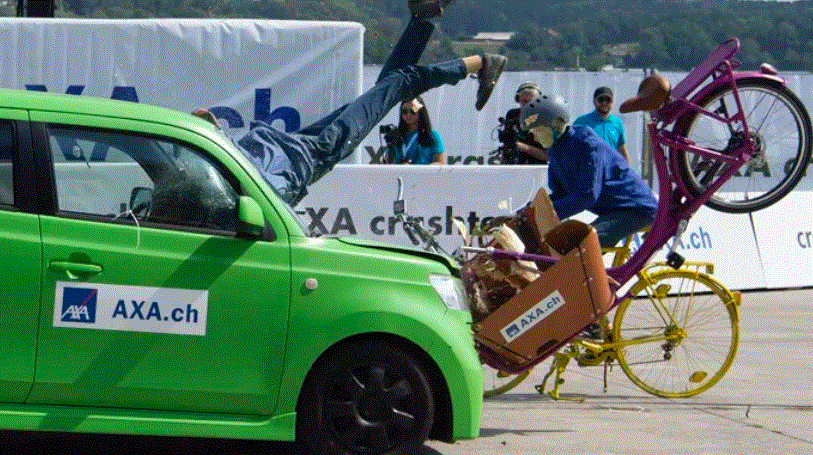Crash test reveals dangerousness
Drones, e-bikes and sharing concepts: Urban mobility will change significantly by 2030. At their crash tests in Dübendorf, Axa accident researchers demonstrate the risks these trends entail in three crash tests.

Changing mobility needs of the population, new concepts such as car or bike sharing, and forward-looking ideas such as transport drones are raising new questions about safety in the city of the future. The year 2030 still seems a long way off. But key decisions regarding infrastructure and legal foundations are being made today.
Drones - new risks from the air
While freight transport is likely to continue to be dominated by trucks and delivery vans in the medium term, new forms of freight distribution via robots and drones are already being tested today. In the private sector, numerous drones are already in the air today - and the number is growing. Most of them are piloted by hobby pilots.
"The first accidents with drones have already happened. Fortunately, so far it has only been property damage. But with the increasing spread of drones, it is only a matter of time before the first personal injuries are also caused by drones," says Bettina Zahnd, Head of Accident Research & Prevention at Axa.
Mandatory labeling required
What can happen when a drone is improperly controlled is shown by the accident insurer in the first crash attempt. A 9 kg transport drone crashes into the side window of a car and breaks into the driver's compartment. For the vehicle occupants, such an accident results in serious to fatal injuries. However, even small drones can cause significant damage or even injure people and animals. To avoid the risk of such accidents, accident researchers are calling for all pilots of a drone weighing 500 g or more to take a mandatory theory test, and for drones weighing 900 g or more to undergo additional practical training.
In addition, all drones weighing 250 g or more are to be registered and marked so that, in the event of an accident, it can be traced to whom the drone belongs.
"Today, anyone who wants to can fly a drone in Switzerland, without any labeling or training. For accident victims, this is a deplorable state of affairs, because in principle the drone pilot is liable for damages to third parties, and his insurance would cover the costs. If the person responsible for the accident cannot be located, the injured party is left to bear the costs," says Zahnd.
In Germany, mandatory labeling for drones weighing 250 g or more has already been in effect since October 2017 - a sticker with the owner's address data must be attached. From 2 kg weight of the drone, the owner must prove special flying skills, for drones from 5 kg weight he needs a permit from the state aviation authority. Drones are only allowed to fly at altitudes above 100 m if they have an exceptional permit from the authorities. A general ban on flying applies above residential properties, nature reserves, crowds of people and industrial plants.
E-bike accidents continue to increase - with serious consequences
During the second crash test in Dübendorf, a cargo e-bike overtakes a conventional bicycle at 45 km/h. The e-bike is then hit head-on by an oncoming passenger car. In the process, it collides head-on with an oncoming passenger car. "Since e-bikes travel faster than conventional bicycles, overtaking maneuvers are becoming more frequent. However, there is usually not enough space for this, especially in the city," says Bettina Zahnd. The crash test illustrates how risky such a maneuver can be - for the e-bike rider, such a collision results in serious to fatal injuries.
While car traffic is becoming safer and safer and fewer passengers are injured every year, accidents involving two-wheelers are steadily increasing. According to Astra, the number of personal injury accidents involving bicycles in Switzerland has increased by 13 percent since 2013, and by more than 130 percent for e-bikes. Two-wheeled accidents also often result in serious injuries, as the rider is usually only protected by a helmet, if at all. While older people are more likely than average to be injured in e-bike accidents, young people are often the victims of bicycle accidents.
Improve two-wheeler infrastructure
According to a survey of 1,000 Swiss people conducted by the accident insurer, 27 percent of 18- to 34-year-olds use bicycles as a means of transport every day or several times a week - and mainly in urban traffic.
"The increase in two-wheelers and e-bikes in the city requires a rethink of the infrastructure. For the city of the future, we need wider and, wherever possible, separate lanes that allow two-wheelers to overtake each other at different speeds," says Bettina Zahnd.
Another risk is the speed of e-bikes. More than 50 percent of the e-bike riders surveyed say that other road users are unable to judge their speed correctly. "Drivers need to get used to the fact that not all bikes are the same," says Bettina Zahnd. In addition, in view of the increasing spread of shared e-bikes in cities, it is also important to raise awareness among e-bike riders - some of whom are inexperienced, she adds. "Often, an e-bike rider himself is not even aware of how fast he is traveling. We therefore recommend the standard installation of speedometers on e-bikes, especially on the fast models," says Zahnd.
Sharing: desirable - but also risky
Another trend for the city of the future is car sharing. As the AXA study shows, young people in particular frequently use the option of borrowing a car from parents or acquaintances. 79 percent of 18-24 year-olds who have a driver's license said they borrow a car privately. Among 25-34 year olds, the figure is 68 percent. In addition, commercial car-sharing providers are also becoming more common. "Sharing is highly desirable for cost, space and environmental reasons," says Bettina Zahnd. "The downside of this trend is that if you don't use a borrowed car regularly, you often lack routine and have to focus on operating the vehicle at the expense of paying attention to traffic," Zahnd says. In the third crash test, an unrouted driver of a passenger car overlooks an e-scooter at an intersection. In the collision with the vehicle, the scooter driver suffers very serious injuries. The passengers in the car, on the other hand, suffer at most minor injuries.
The fact that such accidents will increase can already be seen in the claims statistics. In the last 10 years, claims in the area of "driving other people's vehicles" have more than doubled at Axa Switzerland. "For vehicles that are regularly lent out on a private or commercial basis to other, more untrained drivers, we recommend automatic systems as well as driver assistance systems such as emergency brake assistants and modern parking assistants. These can help reduce the number of accidents," says accident researcher Zahnd.
Silent traffic challenges all senses
In the case of electric vehicles, the lack of noise should not be underestimated as a risk factor. "Unlike other cars, electric cars are extremely quiet when starting up. Until now, people were used to hearing other road users. Today, you are increasingly dealing with very quiet vehicles - not only e-cars, but also e-bikes and e-scooters. So you can rely less and less on your ears and have to use all your senses," explains Zahnd.
Demands of the accident researchers
For drones:
- Europe-wide marking and registration obligation for all drones weighing 250 g or more
- Compulsory theory test for all pilots with a drone weighing 500 g or more, for drones weighing 900 g or more an additional practical training is required
- Technical requirements: Drones should be able to automatically detect no-fly zones
- Air traffic control: flights of drones weighing 2 kg or more should be registered so that other air traffic is informed accordingly
- Europe-wide harmonization of drone categories and laws. At the moment, different rules apply to the same drone depending on the country
For two-wheeled traffic / e-bikes:
- Separate lanes for bicycles, e-bikes and other one- to two-wheelers, separated from the road and from pedestrian paths
- Wider lanes so that fast e-bikes can overtake slower two-wheelers
- For fast e-bikes, a speedometer must be provided as standard so that the rider always knows how fast he is going and can adapt his speed to the road conditions and the maximum speed
Source: Axa









